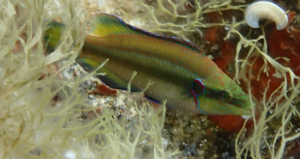The How and Why of Alternative Reproductive Tactics


One might expect evolution to favor one “best” way to mate and reproduce in a given environment. Instead, what we actually find is that many populations exhibit both continuous and discrete variation in reproductive behaviors and mating patterns. These alternative reproductive tactics can arise from a genetic polymorphism or because individuals respond plastically to an aspect of their environment or individual state. Alternative reproductive tactics are found across taxa and in both sexes. In our main study organism, the ocellated wrasse, three distinct alternative male types (ARTs) exist: 1) Large colorful ‘nesting’ males build nests of algae, court females, care for eggs, and attempt to prevent mating by other males. 2) Smaller ‘sneaker’ males attempt to join a nesting male and female during mating, but do not court females or provide care. 3) ‘Satellite’ males court females, chase sneakers and are tolerated by the nesting male, but sneak spawns at the nest and do not provide care. Males change types between but not within reproductive seasons; these ARTs are not determined by a simple genetic polymorphism, but fall along two pre-reproductive growth dependent life-history pathways (“sneaker then satellite” or “satellite then nesting male”). Early work focused on understanding the evolution of these alternate male tactics and describing how they differ. More recently, we have been studying the hormonal, genetic, and neural mechanisms underlying social interactions among alternative male types in this species. This research focused first on identifying the mechanisms associated with variation in social and reproductive behavior. We are now using this knowledge to measure how variation in these mechanisms contributes to the evolution and expression of reproductive traits and social interactions in this species and in comparison to other species.
Want to know more? See one of the papers listed before or a complete list HERE
Dean R, Wright AE, Marsh-Rollo SE, Nugent BM+, Kindsvater HK+, Alonzo SH, Mank JE. 2017. Sperm competition shapes gene expression and sequence evolution in the ocellated wrasse. Molecular Ecology 26: 505–518 (http://dx.doi.org/10.1111/mec.13919)
Nugent BM+, Stiver KA+, Alonzo SH, Hofmann HA. 2016. Neuroendocrine profiles associated with discrete behavioral variation in Symphodus ocellatus, a species with male alternative reproductive tactics. Molecular Ecology 25: 5212-5227 (http://dx.doi.org/10.1111/mec.13828)
Stiver KA +, Harris RM, Townsend JP, Hofmann HA, Alonzo SH. 2015 Neural gene expression profiles and androgen levels underlie alternative reproductive tactics in the ocellated wrasse, Symphodus ocellatus. Ethology 120:1-16 (http://dx.doi.org/10.1111/eth.12324)
Alonzo SH, Warner RR. 2000. Female choice, conflict between the sexes and the evolution of male alternative reproductive behaviors. Evolutionary Ecology Research 2: 149-170 (http://www.evolutionary-ecology.com/issues/v02n02/ddar1136.pdf)
Henson (Alonzo) S, Warner RR. 1997. Male and female alternative reproductive behaviors in fishes: A new approach using intersexual dynamics. Annual Review of Ecology and Systematics 28: 571-92 (http://dx.doi.org/10.1146/annurev.ecolsys.28.1.571)